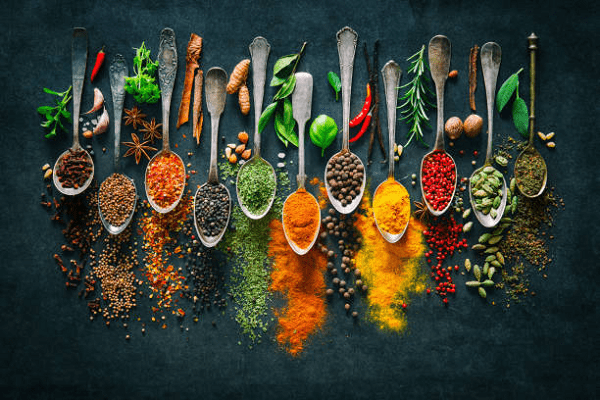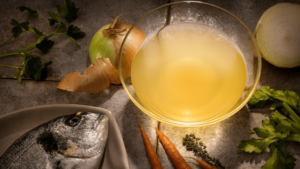Spices- Spices are aromatic substances obtained from the seeds, roots, bark, fruits, or other parts of various plants. They are used primarily for flavoring, coloring, and preserving food. Spices have been an integral part of human culinary history for thousands of years and have played a significant role in the development of cuisines around the world. Here are some common spices and their uses:
- Cinnamon: Derived from the bark of the Cinnamomum tree, cinnamon is used in both sweet and savory dishes. It adds warmth and sweetness to desserts and can also be used in spice blends and curries.
- Cumin: Cumin seeds are known for their earthy, nutty flavor and are commonly used in Indian, Mexican, and Middle Eastern cuisines. They add depth to curries, stews, and chili.
- Coriander: Coriander seeds and ground coriander are used in a wide range of dishes, providing a citrusy and slightly sweet flavor. The leaves of the coriander plant, known as cilantro, are also used as an herb.
- Paprika: Paprika is made from dried and ground peppers and is commonly used to add color and flavor to dishes. It ranges in flavor from sweet to hot and is often used in Spanish and Hungarian cuisine.
- Turmeric: This bright yellow spice is known for its earthy, slightly bitter flavor. It’s a key ingredient in curry powder and is used in many Indian and Southeast Asian dishes.
- Ginger: Ginger has a zesty, slightly spicy flavor and is used in both sweet and savory dishes. It’s a common ingredient in Asian and Indian cuisine and is also used in baking.
- Black Pepper: Black pepper is one of the most widely used spices globally, known for its pungent and spicy flavor. It’s used to season a wide variety of dishes.
- Nutmeg: Nutmeg is used in both sweet and savory dishes and has a warm, nutty flavor. It’s often used in baking, as well as in sauces and soups.
- Cloves: Cloves have a strong, sweet, and spicy flavor and are often used in spice blends like pumpkin pie spice. They are also used in pickling and to flavor certain meats.
- Cardamom: Cardamom pods contain small black seeds that have a sweet, floral, and slightly spicy flavor. It’s used in both sweet and savory dishes, particularly in Indian and Middle Eastern cuisines.
- Chili Powder: A blend of ground chili peppers and other spices, chili powder adds heat and flavor to Mexican and Tex-Mex dishes.
- Vanilla: While technically not a spice, vanilla is often included in discussions of spices. Vanilla extract is commonly used in baking to add a sweet and fragrant flavor.
These are just a few examples of the countless spices used in global cuisines. Different cultures have their own unique blends of spices and herbs that contribute to the diversity of flavors found in food around the world. Spices not only enhance the taste of dishes but also often have medicinal and health-promoting properties.
What is Spices
Spices are aromatic substances obtained from various parts of plants, such as seeds, roots, bark, fruits, or leaves, that are used to flavor, season, and enhance the taste of food. These plant-based substances are typically dried and ground into powders or used whole, and they play a vital role in culinary traditions around the world.
Spices are used to add a wide range of flavors to dishes, from sweet and aromatic to hot and pungent. They can be used to create complex and balanced flavor profiles in various cuisines and are often the key to making dishes more interesting and delicious.
Common examples of spices include cinnamon, cumin, coriander, paprika, turmeric, ginger, black pepper, nutmeg, cloves, cardamom, and many more. Each spice has its unique flavor profile and can be used in both sweet and savory recipes. Spices are often used in various forms, such as whole seeds, ground powders, or as part of spice blends and seasonings.
Throughout history, spices have been highly prized commodities, often traded over long distances. They have been used not only for culinary purposes but also for medicinal, preservative, and even religious purposes in different cultures. Today, spices continue to be an essential part of global cuisine, providing depth, aroma, and flavor to a wide variety of dishes.
Types of Spices

Spices come in a wide variety of types, each with its unique flavor, aroma, and culinary uses. Here are some common types of spices:
- Cinnamon: Derived from the bark of the cinnamon tree, it has a sweet and warm flavor. It’s used in both sweet and savory dishes, as well as in baking.
- Cumin: Known for its earthy, nutty flavor, cumin is widely used in Indian, Mexican, and Middle Eastern cuisines. It’s a key ingredient in curry powders and spice blends.
- Coriander: Coriander seeds and ground coriander have a citrusy and slightly sweet flavor. The leaves of the coriander plant, known as cilantro, are also used as an herb.
- Paprika: Made from dried and ground peppers, paprika adds color and flavor to dishes. It varies in flavor from sweet to hot and is used in Spanish and Hungarian cuisine.
- Turmeric: This bright yellow spice has an earthy and slightly bitter flavor. It’s a primary ingredient in curry powder and used in many Indian and Southeast Asian dishes.
- Ginger: Ginger has a zesty and slightly spicy flavor. It’s used in both sweet and savory dishes and is common in Asian and Indian cuisines.
- Black Pepper: Known for its pungent and spicy flavor, black pepper is one of the most widely used spices globally. It’s used to season a wide range of dishes.
- Nutmeg: Nutmeg has a warm and nutty flavor and is used in both sweet and savory dishes, including baked goods, sauces, and soups.
- Cloves: Cloves have a strong, sweet, and spicy flavor. They are used in spice blends like pumpkin pie spice and in pickling.
- Cardamom: Cardamom pods contain small black seeds with a sweet, floral, and slightly spicy flavor. They are used in both sweet and savory dishes, particularly in Indian and Middle Eastern cuisines.
- Chili Powder: A blend of ground chili peppers and other spices, chili powder adds heat and flavor to Mexican and Tex-Mex dishes.
- Vanilla: While not a traditional spice, vanilla is often included in discussions of spices. Vanilla extract is used in baking and adds a sweet and fragrant flavor.
- Saffron: Saffron is the most expensive spice in the world and is known for its vibrant color and unique flavor. It’s used in various cuisines, including Mediterranean and Indian.
- Fennel Seeds: These have a sweet and slightly licorice-like flavor and are used in Italian sausages, Indian spice blends, and Mediterranean dishes.
- Mustard Seeds: Mustard seeds come in various varieties and can be used to make mustard condiments or to add flavor to dishes.
- Allspice: Allspice has a flavor reminiscent of a combination of cloves, cinnamon, and nutmeg. It’s used in both sweet and savory recipes.
- Sumac: Sumac has a tart, citrusy flavor and is used as a seasoning in Middle Eastern and Mediterranean cuisine.
These are just a few examples of the many spices used in cooking around the world. Different cultures and cuisines use a diverse range of spices to create unique and flavorful dishes.
Where is Required Spices
Spices are not located in a specific place as they are products that are produced, traded, and used worldwide. Spices are derived from various parts of plants, such as seeds, roots, bark, fruits, or leaves, and they are grown in many different regions around the world. The availability of spices can vary depending on the type of spice and where it is cultivated.
Spices can typically be found in several places:
- Grocery Stores: Most grocery stores carry a variety of spices in their spice aisle. They are often available in both whole and ground forms.
- Specialty Spice Shops: Some areas have specialty spice shops that offer a wide range of spices, including rare and exotic ones. These stores may offer a more extensive selection and higher-quality spices.
- Online Retailers: Many online retailers and e-commerce platforms sell spices, making it convenient to order and have them delivered to your doorstep.
- Local Markets: In regions where spices are cultivated locally, you may find them in local markets or from farmers and growers.
- Import Stores: Specialty import stores often carry spices from various parts of the world, allowing you to explore international flavors.
The availability of spices may vary depending on your location and the specific spices you’re looking for. Spices are a fundamental part of culinary traditions worldwide and are readily accessible for those who wish to use them in cooking and seasoning dishes.
How is Required Spices
Spices are typically derived from various parts of plants, such as seeds, roots, bark, fruits, or leaves, and they are processed in different ways to make them suitable for culinary use. Here’s how spices are generally produced:
- Harvesting: Spices are obtained from the specific part of the plant that contains the aromatic compounds responsible for their flavor and aroma. For example, cinnamon is derived from the bark of the cinnamon tree, while black pepper comes from the berries of the pepper plant. Spices are usually harvested when the plant parts are at their peak maturity.
- Drying: After harvesting, the plant material is typically dried to reduce moisture content. Drying is an essential step in preserving spices and intensifying their flavor. Depending on the spice, drying can be done through sun-drying, air-drying, or other methods.
- Processing: Some spices are used directly in their whole form, while others are processed further. For example, spices like cinnamon and cloves may be ground into a fine powder. Spices can be processed in various ways, including grinding, crushing, or pulverizing, depending on the desired end product.
- Packaging: Once dried and processed, spices are often packaged to protect them from moisture, light, and air, all of which can degrade their quality. Spices are typically stored in airtight containers, bottles, or pouches.
- Distribution: Spices are distributed to various markets and retailers, both locally and internationally. They are commonly available in grocery stores, specialty spice shops, and online marketplaces.
- Culinary Use: Spices are used in cooking to add flavor, aroma, and depth to dishes. They can be used in a variety of ways, such as sprinkled directly onto food, incorporated into spice blends, or used in the preparation of sauces, marinades, and seasonings.
The specific process for each spice can vary depending on its type and origin. Different spices have distinct characteristics, and their preparation methods may differ accordingly. Spices have been an integral part of human cuisine for thousands of years, contributing to the diverse and rich flavors found in culinary traditions around the world.
Case Study on Spices
Title: The Global Spice Trade: Challenges and Opportunities
Introduction: The spice industry has a long and storied history, dating back thousands of years. Spices are essential components of culinary traditions worldwide, adding flavor, aroma, and diversity to dishes. This case study explores the dynamics of the global spice trade, highlighting the challenges and opportunities faced by various stakeholders in this industry.
Background: The global spice trade involves the cultivation, processing, and distribution of a wide range of spices, including but not limited to black pepper, cardamom, cinnamon, cumin, and turmeric. Spices are sourced from different regions, each known for its unique varieties and quality.
Challenges:
- Supply Chain Vulnerability: The spice industry faces supply chain vulnerabilities due to climate change, natural disasters, and political instability in some spice-producing regions. These disruptions can affect spice production and availability.
- Quality Control: Ensuring consistent quality and safety standards across the spice supply chain is a significant challenge. Contamination, adulteration, and pesticide residues can undermine the reputation of spice producers and distributors.
- Sustainability Concerns: As consumer awareness of sustainability and environmental issues grows, there is increasing pressure on the spice industry to adopt sustainable farming and processing practices to protect ecosystems and support local communities.
- Regulatory Compliance: Compliance with international food safety regulations and labeling requirements presents a complex challenge for spice exporters, especially small-scale farmers and producers in developing countries.
Opportunities:
- Growing Demand for Authentic Flavors: As global cuisines become more popular, there is a growing demand for authentic spices and spice blends from different regions. This trend offers opportunities for niche spice producers to market their unique products.
- Health and Wellness Trends: Spices are increasingly recognized for their potential health benefits. The spice industry can capitalize on this by promoting spices as functional ingredients with various health properties.
- E-commerce and Direct-to-Consumer Sales: The rise of e-commerce platforms and direct-to-consumer sales channels allows spice producers to reach a broader audience and tell their brand story, enhancing consumer engagement.
- Collaboration for Sustainability: Collaborative efforts between spice-producing regions, governments, and industry stakeholders can lead to sustainable spice farming practices, benefiting both the environment and local communities.
Conclusion: The global spice trade is a complex and dynamic industry with challenges and opportunities for various stakeholders. To thrive in this competitive landscape, spice producers and distributors must address supply chain vulnerabilities, ensure quality control, embrace sustainability, and adapt to changing consumer preferences. Collaboration, innovation, and a commitment to delivering high-quality spices can help the industry navigate these challenges and continue to spice up cuisines worldwide.
White paper on Spices
Title: Spices: A Journey through Flavor, Culture, and Health
Abstract:
- Provide a brief overview of the contents and importance of the white paper.
Table of Contents:
1. Introduction
- Introduce the importance of spices in global cuisine.
- Highlight the historical significance of spices in trade and culture.
2. A World of Spices
- Provide an overview of the most commonly used spices globally.
- Discuss the botanical sources of spices and their geographic origins.
3. The Spice Trade
- Explore the historical spice trade routes and their impact on world history.
- Analyze the modern spice industry, including production, distribution, and key players.
4. Culinary Uses of Spices
- Describe how spices are used in different cuisines around the world.
- Provide examples of signature dishes that rely on specific spices.
5. Health Benefits of Spices
- Investigate the medicinal properties and health benefits of various spices.
- Discuss the role of spices in traditional medicine and alternative therapies.
6. Challenges in the Spice Industry
- Examine the challenges faced by spice producers, including climate change, supply chain issues, and quality control.
- Discuss regulatory challenges and food safety concerns in the spice industry.
7. Sustainability and Ethical Practices
- Highlight sustainable farming practices and ethical considerations in the spice industry.
- Discuss efforts to promote fair trade and support local spice-producing communities.
8. Spice Blends and Innovation
- Explore the creation of spice blends and their role in modern cooking.
- Discuss innovative uses of spices in the culinary and beverage industries.
9. Future Trends in Spices
- Predict future trends in the spice industry, such as the emergence of new spices and changing consumer preferences.
- Discuss the potential impact of technology and globalization on spice production and consumption.
10. Conclusion
- Summarize the key takeaways from the white paper.
- Emphasize the enduring importance of spices in our culinary and cultural heritage.
References:
- Provide a comprehensive list of sources, including academic research, industry reports, and books, used to compile the white paper.
Appendices:
- Include supplementary information, such as spice profiles, recipes, or case studies, if applicable.
This outline serves as a framework for creating a white paper on spices. Each section can be expanded with relevant data, statistics, case studies, and expert insights to provide a comprehensive and informative resource on the topic of spices.





